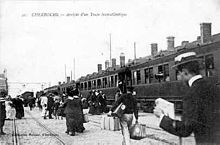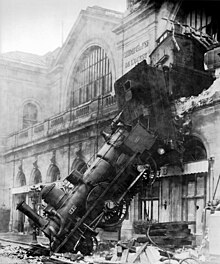Chemins de fer de l'Ouest


The Compagnie des chemins de fer de l'Ouest , also known as "l'Ouest" , was a French railway company that existed from 1855 to 1909.
Geographical location
The catchment area of the Ouest extended from the Parisian train stations of Saint-Lazare and Montparnasse, with many branches to Normandy and Brittany . The routes of the Ouest connected the routes of the Chemins de fer du Nord with those of the Chemin de fer Paris-Orléans .
history
founding
The company was founded on April 7, 1855 by the merger of several railway companies, the main lines Paris - Versailles - Saint-Germain-en-Laye (with the station Saint-Lazare ), Paris - Rouen , Rouen - Le Havre , Paris - Rennes and Paris - Caen - Cherbourg brought in. The government decree establishing the company approved grants and interest guarantees at the same time, but also obliged the company to build more than 800 km of new routes in Normandy and Brittany. The length of the licensed routes in 1855 was 2,079 km.
expansion
According to contracts of July 29, 1858 and June 11, 1859 (decree of June 11, 1859), the Ouest jointly with the Nord received the concession for the Rouen– Amiens line , as well as for the Paris– Dieppe , Pont-l'Évêque - Trouville-sur-Mer and Laigle - Conches-en-Ouche . The "Ouest" received further concessions in 1863 for 164 km of routes, in 1865 for the southern section ("Rive Gauche") of the Chemin de Fer de Petite Ceinture , the inner Parisian belt railway, and until 1875 for a further 300 km of routes. Ten of the licensed lines were to be carried out over an extension of 110 km at the company's expense alone. Subsidies were granted for the remaining four lines . For accounting purposes, the network was split into an old and a new one, with a 4.65% interest rate guarantee for 50 years being granted for the latter . This meant that the state compensated for the difference between the return on the routes and the guaranteed interest rate if necessary.
In 1877, the Ouest was the first railway company in France to test the continuous air brake , which gradually replaced brakes throughout the country from 1880 .
On the basis of a contract dated July 17, 1883 and the law of November 20, 1883, Ouest received further concessions for lines of 1,185 km in length, conditional concessions for a further 233 km and the option of 200 km of not yet determined lines. In addition, the state ceded 877 km of lines from the State Railroad Compagnie des chemins de fer de l'État (ETAT) to the Ouest . In return, the company undertook to take over the operation of local railways in its catchment area in accordance with government regulations.
At the end of 1883, the licensed route length was 5,731 km, of which 3,917 km were in operation. In 1885 the General Assembly approved an expense of 10,000 francs per kilometer for the construction of double-track lines, while the state promised a subsidy until 1956 to pay interest on loans taken out for this purpose . The general assembly also approved the company to participate in a narrow-gauge Breton railway network, which was to be built over 97 km of single-track meter gauge . Further line concessions were granted until 1902.
The company often obtained locomotives from Great Britain .
In 1895 there was a railway accident involving an Ouest locomotive at Montparnasse station in Paris. After crossing a buffer stop , the locomotive crashed onto the station forecourt. The photo of the crashed locomotive doing a “handstand” in front of the facade of the station is very well known and is still used today.
nationalization
Despite its constant expansion and the support in some areas by the state, the company was mostly in an economically precarious situation, as it served structurally weak areas in north-west France with relatively little traffic and a relatively long route. As a result, the state was ultimately forced to take over the railway. Due to the law of December 18, 1908, Ouest was nationalized on January 1, 1909 and taken over by the state railway ETAT. However, the Ouest was to formally remain in existence until 1956 to fully repay its liabilities. At the end of 1910, the main railway network of the nationalized Ouest in operation comprised 6,068 km. As a result of the merger, ETAT, which was founded in 1878 as a rescue company for some ailing railways, was given its own train stations in Paris for the first time.
literature
- Victor von Röll: Encyclopedia of the Railway System . Keyword: French Western Railway . Berlin, Vienna 1914.
- Stefan Vockrodt: Westbahnen and ETAT . In: Railways in Paris = Railway History Special 2 (2015). ISBN 978-3-937189-94-9 , p. 12.
Individual evidence
- ↑ Philippe Callé: The Petite Ceinture of Paris . In: Railways in Paris = Railway History Special 2 (2015). ISBN 978-3-937189-94-9 , pp. 42-45 (43).
- ↑ Didier Janssoone: L'Histoire des chemins de fer pour les nuls . Éditions First, Paris 2015, ISBN 978-2-7540-5928-2 , pp. 34 .
- ↑ a b Vockrodt.
- ^ Eisenbahndirektion Mainz (ed.): Official Journal of the Royal Prussian and Grand Ducal Hessian Railway Directorate in Mainz of January 16, 1909, No. 2. Announcement No. 33, p. 12.

